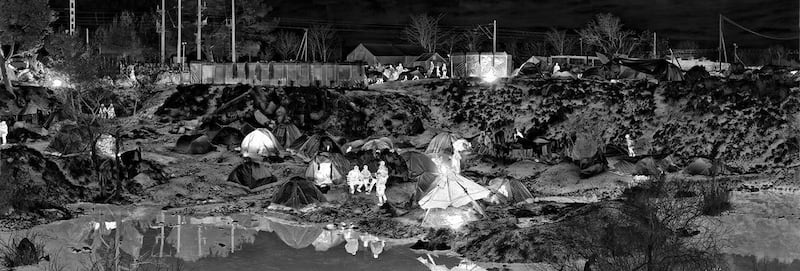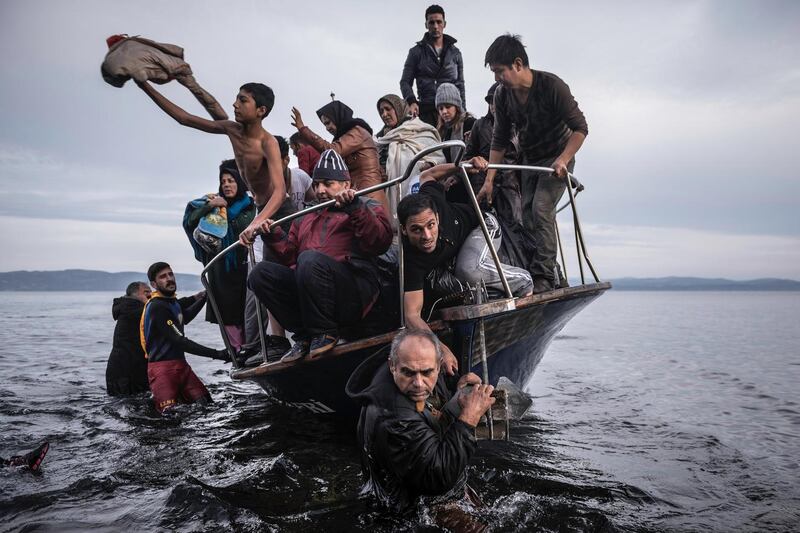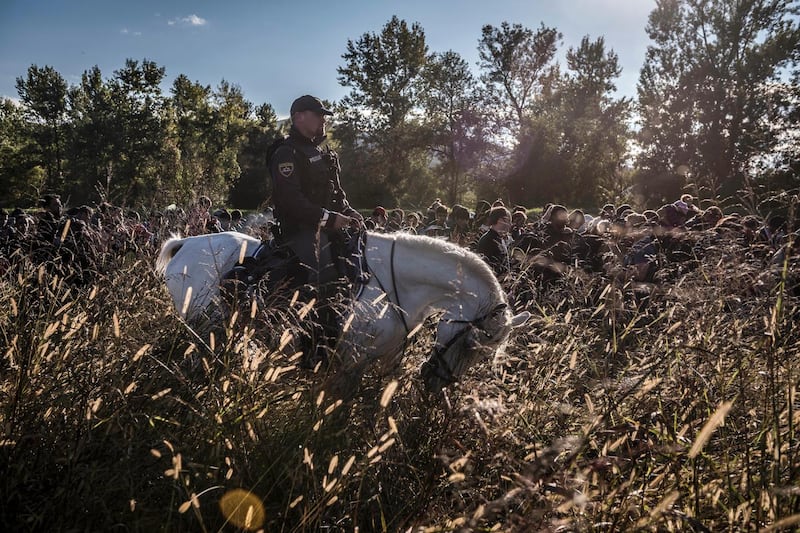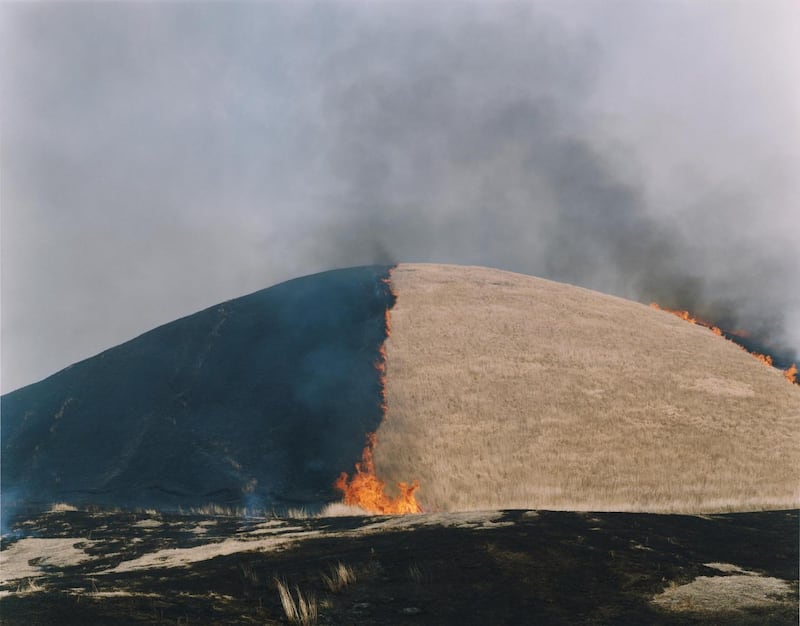Technically, Prix Pictet: Space at the Gallery of Photography is Prix Pictet 2017. It was in May 2017 that Irish artist Richard Mosse won the prestigious and lucrative – just over €90,000 – international photography prize.
It really is international, spanning the globe in its reach, so Moss's achievement is considerable. The shortlist exhibition has been on tour since. Several of Moss's winning series of photographic works, Heat Maps, are on view, with generally smaller selections of work by 11 other contenders.

In fact, Prix Pictet is heavy on logistics, and the process had begun the year before, when an extensive panel of nominators put forward work by a daunting 700 photographers.
In October, an eight-person jury, including the celebrated Brazilian photographer Sebastião Salgado, Financial Times Arts Editor Jan Dalley and the previous prizewinner Valérie Belin, whittled the 700 down to a shortlist of 12 and then, having viewed the shortlist show, selected Mosse as the winner.
The jury was charged with bearing in mind the theme of space, but the Prix Pictet also has a consistent underlying thematic priority, that of global sustainability.
The appeal of Mosse’s work is clear. It addresses the refugee crisis in an ingenious and novel way. His eerie, panoramic images, in a ghostly greyish monochrome, were made with a military thermal camera equipped with an extreme telephoto lens, very extreme, given that it can see body heat to distances in excess of 30km.

Mosse situated himself at vantage points from which he could survey refugee camps and staging sites, set up a robotic motion control tripod, and essentially scanned composite views of the locations.
The images were see are coherent and seamless, but each is made up of a grid of nearly a thousand individual frames stitched together.
Large in scale and intricately detailed in a way that recalls, as the catalogue notes, paintings by Bruegel or Bosch, the images are certainly impressive.
Perhaps it is their basis in the technology of military surveillance that also gives them a creepy, voyeuristic quality.
Mosse himself was clearly aware of the problematic aspect of what he was doing
Mosse's earlier work, Infra, which similarly used an unconventional photographic means with a military dimension, false colour infrared film, in exploring aspects of the conflict in the Democratic Republic of Congo, was inevitably criticised on the basis that he was exoticising his subjects.
That the images make for uneasy if fascinating viewing is perhaps a positive. The press release is alert to a risky ambivalence.
“The work is sinister and objectifying, while also being deeply empathetic and strangely intimate. It provokes a powerful and complex response in the viewer” – well, that is for the viewer to find out.
Mosse himself was clearly aware of the problematic aspect of what he was doing, arguing that while the images might seem to place the subjects at an anonymous remove, in recording the biological essence of body heat they also emphasise common humanity.
Actually, in the mechanics of order, enclosure and control that they evoke, they are also chilling, and a stark reminder of the common and disastrous practice of allowing one group of people authority over another.
In his work, Russian-born Sergey Ponomarev also addresses the migration crisis, in a more conventional, photojournalistic way.

His work recalls a bleak side of 20th century European history: tired and desperate people herded into lines and groups, columns trekking across endless expanses, the vital importance of the correct documents, the uniformed, imperious guards, riot police and the army, he notes, who were trained to deal aggressively with soccer hooligans or other forms of civil unrest and are singularly unfitted to cope with people in extremis.
Differences
Ponomarev is empathetic. His eye is exceptional, his images are perfectly composed, classical to the point where you wonder if he set the whole thing up, but in fact he was just there, on the ground, in the space. Certainly, one can see why the jury would go for the cooler, more conceptual work of Mosse, for its novelty apart from anything else.
His and Ponomarev’s work represent two radically different kinds of photography. It’s an issue that arises all the time: the presumption that there is one perfect image that best conveys a point or a subject.

But there are different approaches, and none is more valid than another, though in the photojournalistic sense of telling a story, Ponomarev definitely has the edge, and his sentiment that we might “begin to create our shared, peaceful living space” is something that sure needs to be expressed more often these days.
It may not be quite the last refuge of a scoundrel, but a prescribed “theme” is certainly not a recipe for great art, and Space is a word ambiguous enough to cover practically anything.
Still, the jury have harnessed the theme to their selections and set them to work ploughing the field.
The almost whimsical inclusion of Thomas Ruff’s colourised versions of images of the Martian surface, from NASA’s Mars Reconnaissance Orbiter, are a case in point.
No reflection on Ruff, who is a considerable artist, but his inclusion seems like box-ticking: space, the final frontier.

Not so the Japanese photographer Rinko Kawauchi, and her project includes photographs of the night sky. Her main focus is on a specific example of yakihata, the process of controlled field burning in advance of planting.
A chance glimpse of an image that corresponded to a dream led her to Aso, where the technique has been practiced for 1,300 years.
Her photographs are extraordinary and, incidentally, perfectly matched, by accident rather than design, with the linked thematic concerns of space and sustainability.

The shortlist comprises fascinating work, while the exhibition could do with more space to include more work.
Well worth mentioning are Michael Wolf’s Japanese commuter photographs, Benny Lam’s claustrophobic studies of Hong Kong living spaces, Sohei Nishino’s dioramas, plus Pavel Wolberg and Munem Wasif.
Prix Pictet | SPACE, the global photographic prize shortlist exhibition runs at the Gallery of Photography, Meeting House Square, Temple Bar, Dublin until January 20th, galleryofphotography.ie












